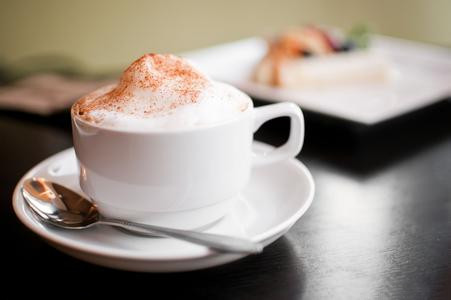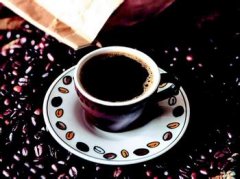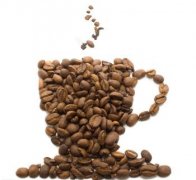Coffee is basically used as four nouns for commercial coffee.

[Latin scientific name] used as four kinds of commercial coffee:
Big fruit coffee Coffea liberica
Medium fruit coffee Coffea canephora
Small fruit coffee Coffea arabica
High yield coffee Coffea dewevrei
Coffea is a coffee tree.
Coffee
[alias] small seed species, also known as Arabian species
Mid-grain species, also known as Ganfla species.
Large seed species, also known as Liberian species.
There are two kinds of common: Arabica and Robusta.
[family and genus]
Domain: eukaryotic domain Eukaryote
Realm: Plantae of the plant kingdom
Phylum: angiosperm phylum Magnoliophyta
Class: dicotyledonous class Magnoliopsida
Item: Gentianales
Family: Rubiaceae of Rubiaceae
Genus: coffee genus Coffea
[ecological characteristics]
Coffee is a shallow root crop, with all levels of branches and secondary branches, direct branches, stem growth has obvious apical dominance, straight stem; leaves opposite, individual trefoil, green (lighter), leathery, glossy, long oval or oval, leaf margin shape, leaf tip and leaf veins vary with variety lines and shading conditions; flowers axillary, Cymes, pedicels short, white, fragrant The oval berry is red or purplish red when ripe. The shape of the navel (top) of the coffee fruit varies from variety to variety. Coffee has the characteristics of multiple flowering and concentrated florescence. Flowering is greatly affected by climate, especially rainfall and temperature. The time from flowering to ripening and the rate of development of coffee fruits vary with species.
In the soil with loose, fertile, deep soil layer and good drainage, the pH (acid mute) value of 66.5 is the most suitable for root development and plant growth. In the process of phylogeny, habits such as quiet wind, warm and cool, shaded or semi-shaded, moist environment are formed.
[distribution at home and abroad]
Coffee is native to the tropical regions of northern and central Africa and has been cultivated for more than 2000 years. The main growing areas of coffee trees are Brazil, Colombia, Jamaica, Puerto Rico, Cuba, Haiti, Mexico, Guatemala, Honduras in Latin America; C ô te d'Ivoire, Cameroon, Guinea, Ghana, Central Africa, Angola, Congo, Ethiopia, Uganda, Kenya, Tanzania, Madagascar in Africa; Indonesia, Vietnam, India and Philippines in Asia. According to statistics, coffee is cultivated in 76 countries in the world.
The main consumption areas are Europe and the United States. Coffee in China was first introduced in Taiwan in 1884. In 1908, overseas Chinese brought back large and medium seeds from Malaysia to Hainan Island. At present, the main cultivation areas are Yunnan, Guangxi, Guangdong and Hainan.
[main ingredients of coffee]
Caffeine: caffeine is the most eye-catching of all the ingredients in coffee. It belongs to a kind of phytoxanthine (animal muscle component). It has the same properties as theophylline contained in cocoa, green tea contains the same theophylline, and the percentage of reduction after baking is very small. Caffeine has a very extensive effect. It will affect various parts of the human brain, heart, blood vessels, gastrointestinal tract, muscles and kidneys. The right amount of caffeine will stimulate the cerebral cortex, promote sensory judgment, memory and emotional activity, and make the myocardial machinery more active. Vasodilation enhances blood circulation and improves metabolic function. Caffeine can also reduce muscle fatigue and promote digestive juice secretion. In addition to this, because it also promotes the kidney function to help the body expel excess sodium ions (chemicals that hinder the metabolism of water molecules), caffeine will not accumulate in the body like other narcotic and excitant substances (narcotic drugs, paint solvents, stimulants, etc.) and will be excreted in about two hours. The biggest special treat in the flavor of coffee
Tannin: after extraction, tannin will turn into a yellowish powder, which is easy to blend into water. After boiling, it will decompose and produce pyrosylic acid, which will make the coffee taste worse. If you brew it well and leave it for several hours, the color of the coffee will become stronger than when it was just brewed. And it is also less tasty, so there is the saying that "it is best to drink it as soon as possible."
Fat: the fat contained in coffee plays a very important role in flavor. It is found that there are many kinds of fat in coffee, the most important of which are acidic fat and volatile fat. Acidic fat means that there is acid in fat, and its strength varies with different types of coffee, and volatile fat is the main source of coffee aroma. Once the fat in roasted coffee beans comes into contact with the air, it will change chemically and the taste will get worse.
Protein: the main source of calorie is protein, and like dripping coffee, most of the protein will not dissolve, so no matter how much coffee you drink, the nutrition you get is limited, which is why coffee will become a dieter's sacred food.
Sugar: without sugar, you will not only feel the bitterness of caffeine and the sour taste of tannin, but also feel sweet, which is caused by the sugar contained in the coffee itself. After baking, most of the sugar will be converted to caramel, bringing a unique brown to the coffee.
Minerals: there are lime, iron, sulfur, sodium carbonate, phosphorus, chlorine, silicon and so on, because the proportion of very little affect the flavor of coffee is not big, combined to bring only a little astringent taste.
Crude fiber: raw bean fiber will be carbonized after baking, this carbon and sugar caramelization combine with each other to form the tone of coffee, but the fiber turned into powder will have a considerable impact on the flavor of coffee. Therefore, we do not encourage the purchase of powdered coffee beans, because we are unable to taste the flavor of the coffee.
The bitterness of coffee: the color, aroma, and taste of coffee are caused by complex chemical changes that take place during roasting. Therefore, raw beans must go through appropriate chemical procedures to achieve the most balanced state of its essential ingredients in order to be regarded as the best baked beans. The aroma of coffee changes with the heat, so the baking time should be shortened as much as possible, and the heat should be controlled at the lowest temperature that can produce effective chemical composition of coffee beans, that is, the time and heat of the shortest process, so that coffee beans can produce the most suitable composition ratio.
Aroma: aroma is the life of coffee quality, and it can best represent the coffee production process and baking technology, as well as the climate, elevation, variety, refined treatment, harvest, storage, roasting technology of the consuming country, etc. are the conditions that determine the aroma of coffee beans. The results of gas chromatographic analysis showed that the aroma of coffee was composed of acid, alcohol, acetaldehyde, ketone, ester, sulfur compound, phenol, nitrogen compound and nearly hundreds of volatile components. Generally speaking, fat, protein and sugars are important sources of aroma, while lipids blend with the sour and bitter of coffee to form a smooth taste. Therefore, the disappearance of fragrance means that the quality becomes worse, and the relationship between aroma and quality is very close.
[coffee appreciation]
The most commonly used descriptions of the characteristics and flavor of coffee in different places are as follows:
A, alcohol degree (body)
Refers to the thick, thick texture behind the entrance of the coffee.
B, acid (acidity)
Different from the sour taste of our daily fruits, this acid is used to describe the bright, fresh and refreshing taste of coffee. Some famous Arabica coffee beans are loved by coffee lovers because of their bright "sour" characteristics.
C, bitter (bitter)
Bitterness is one of the most obvious features of coffee. The main factors that affect the bitterness are: variety (Robbas is more bitter than Arabica), origin (some coffee products are more bitter, such as Sumatra and Java, Indonesia, etc.); baking degree (deeper roasting is more bitter than shallow roasting); caffeine content (the higher the caffeine content, the more bitter it will be); the extraction time (the longer the extraction time, the more bitter).
D, sweet
Sweet aftertaste is the characteristic of some good coffee. Generally speaking, no one likes "bitter", but the "sweet" and "sour" in the aftertaste are pursued by many people.
E, fragrance (aroma)
Refers to the most obvious characteristics of coffee after brewing, including: caramel, fruit, flower, grass and so on.
F, flavor (flavor)
Refers to the overall feeling of aroma, sweetness and mellowness.
G, wine taste (winy)
Coffee from some places has a wine-like taste, which is essentially a combination of sour taste and high mellowness.
Important Notice :
前街咖啡 FrontStreet Coffee has moved to new addredd:
FrontStreet Coffee Address: 315,Donghua East Road,GuangZhou
Tel:020 38364473
- Prev

Coffee common sense how to tell whether a cup of coffee is good or bad?
Anything beautiful is rich and associative. How to tell whether a cup of coffee is good or bad? Let's start with tea. Chinese people all know that those tea drinks are definitely not tasteful tea, and they are far away from the tea in Chinese mind; we all know that those tea drinks, like cola, fruit juice, etc., have only one taste; and the tea in Chinese mind contains
- Next

Basic knowledge of Fine Coffee Culture Coffee Culture in the Middle East
The trend of Taiwanese drinking coffee, from individual products to fancy styles, from refreshing to leisure, and from urban to rural areas, has become a way of life. It has been popular for more than 50 years, and it has become more and more out of control. I am also involved in it and never return. And do people in the Middle East, like Taiwanese, drink coffee? In the end, those who look smoky on TV, and their heads and faces are always tightly wrapped in scarves.
Related
- Beginners will see the "Coffee pull flower" guide!
- What is the difference between ice blog purified milk and ordinary milk coffee?
- Why is the Philippines the largest producer of crops in Liberia?
- For coffee extraction, should the fine powder be retained?
- How does extracted espresso fill pressed powder? How much strength does it take to press the powder?
- How to make jasmine cold extract coffee? Is the jasmine + latte good?
- Will this little toy really make the coffee taste better? How does Lily Drip affect coffee extraction?
- Will the action of slapping the filter cup also affect coffee extraction?
- What's the difference between powder-to-water ratio and powder-to-liquid ratio?
- What is the Ethiopian local species? What does it have to do with Heirloom native species?

